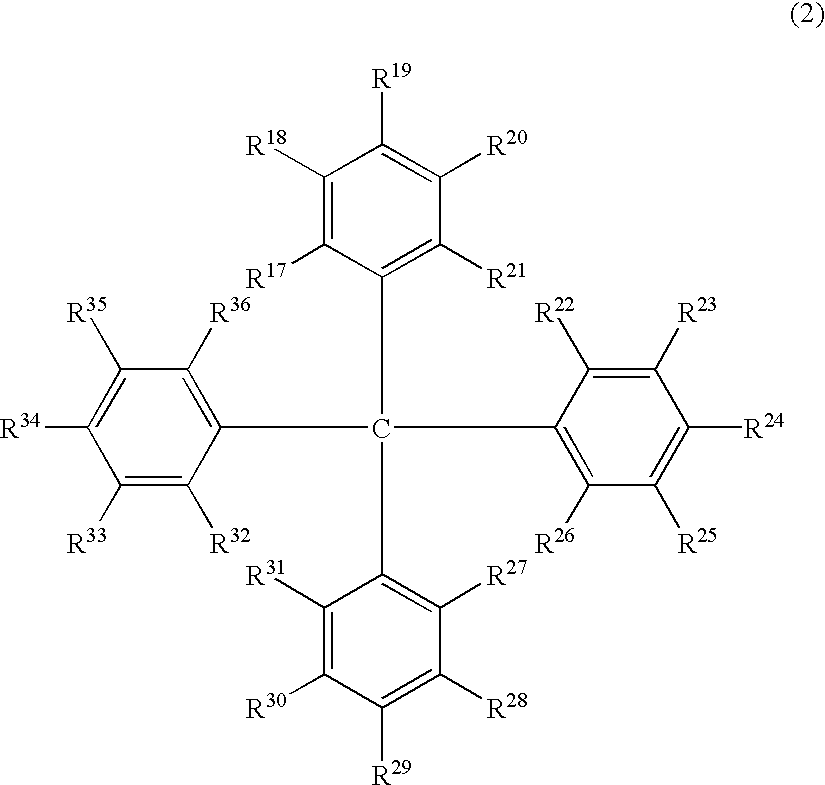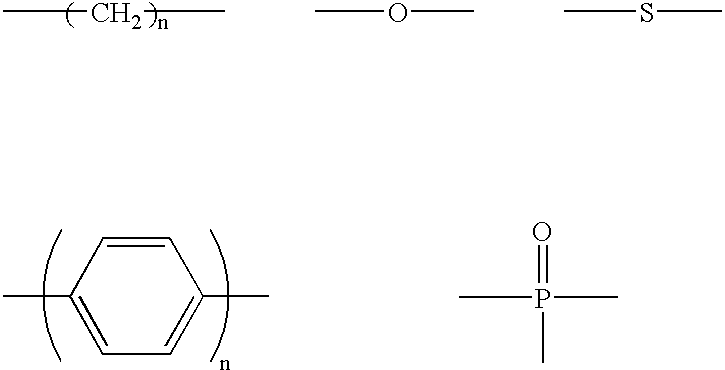Luminescent element material and luminescent element comprising the same
a technology of luminescent elements and materials, applied in the direction of group 5/15 element organic compounds, diaryl/triaryl methane dyes, natural mineral layered products, etc., can solve the problems of poor durability, shorten the life of devices, thin film turns cloudy, etc., and achieves enhanced luminance efficiency, high chromatic purity, and prevent holes very efficiently
- Summary
- Abstract
- Description
- Claims
- Application Information
AI Technical Summary
Benefits of technology
Problems solved by technology
Method used
Image
Examples
example 1
Synthesis of Connecting Unit 1
[0112]14.8 g of 2-bromobiphenyl was converted to the Grignard form in THF using 2.2 g of metal magnesium, then this reacted with 12.3 g of 9-xanthone at from room temperature to 50° C. and, by treatment in the normal way, 9-(2-biphenyl)-9-xanthenol was obtained. This was heated in acetic acid to which a small amount of hydrochloric acid had been added, so that water was eliminated and, by treatment in the usual way, Connecting Unit 1 (8.5 g) shown below was obtained. 1H-NMR (CDCl3, ppm): 7.8 (d, 2H), 7.2 (t, 2H), 7.2 (m, 8H), 6.8 (t, 2H), 6.4 (d, 2H)
[0113]
example 2
Synthesis of Connecting Unit 2
[0114]11.9 g of 2-bromobiphenyl was converted to the Grignard form in THF using 1.7 g of metal magnesium, then this reacted with 13.4 g of 2,4-diethyl-9-thioxanthone at from room temperature to 50° C. and, by treatment in the normal way, 2,4-diethyl-9-(2-biphenyl)-9-thioxanthenol was obtained. This was heated in acetic acid to which a small amount of hydrochloric acid had been added, so that water was eliminated and, by treatment in the usual way, Connecting Unit 2 (13.8 g) shown below was obtained. 1H-NMR (CDCl3, ppm): 7.8 (m, 2H), 7.6 (d, 2H), 7.4 (m, 3H), 7.2 (m, 2H), 7.1 (t, 1H), 6.9 (s, 1H), 6.8 (t, 1H), 6.5 (d, 1H), 6.2 (s, 1H), 2.9 (m, 2H), 2.3 (m, 2H) 1.4 (t, 3H), 0.9 (t, 3H)
[0115]
example 3
Introduction of Acetyl Groups into Connecting Unit 1: Connecting Unit 1′
[0116]Connecting Unit 1 (8.5 g) was reacted with 4.5 g of acetyl chloride and 7.5 g of aluminium chloride at 50° C. in 1,2-dichloroethane and, by treatment in the normal way, Connecting Unit 1′ (13.1 g) shown below was obtained. 1H-NMR (CDCl3, ppm): 8.0 (d, 1H), 7.9 (d, 2H), 7.8 (d, 1H), 7.7 (s, 1H), 7.4 (t, 1H), 7.3−7.1 (m, 5H), 7.0 (s, 1H), 6.8 (t, 1H) 6.3 (d, 1H), 2.5 (s, 3H), 2.3 (s, 3H)
[0117]
PUM
| Property | Measurement | Unit |
|---|---|---|
| cold crystallization temperature | aaaaa | aaaaa |
| cold crystallization temperature | aaaaa | aaaaa |
| cold crystallization temperature | aaaaa | aaaaa |
Abstract
Description
Claims
Application Information
 Login to View More
Login to View More - R&D
- Intellectual Property
- Life Sciences
- Materials
- Tech Scout
- Unparalleled Data Quality
- Higher Quality Content
- 60% Fewer Hallucinations
Browse by: Latest US Patents, China's latest patents, Technical Efficacy Thesaurus, Application Domain, Technology Topic, Popular Technical Reports.
© 2025 PatSnap. All rights reserved.Legal|Privacy policy|Modern Slavery Act Transparency Statement|Sitemap|About US| Contact US: help@patsnap.com



